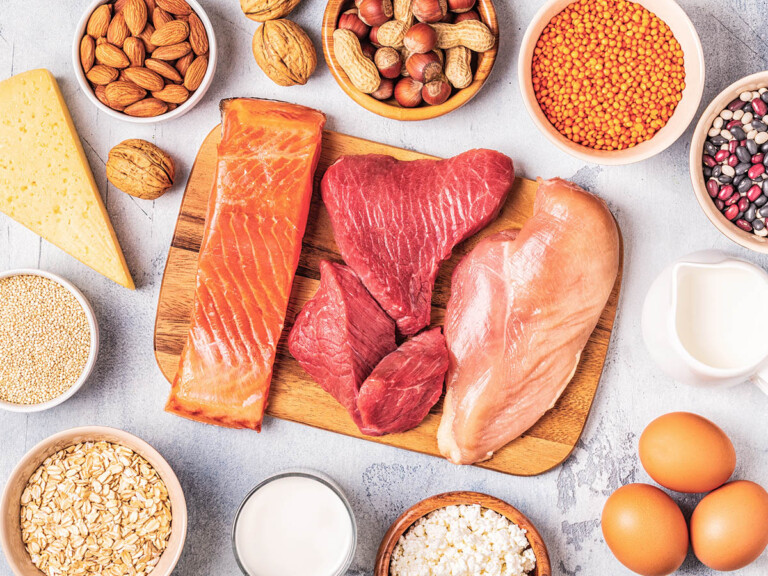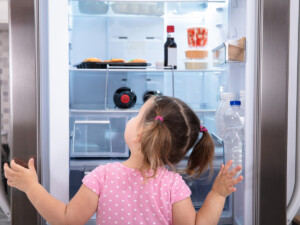


Appropriate nutrition plays a huge role in both initial and long-term success for individuals who are using weight loss injectable medications. New research is finding that without specific nutrition goals being met, a person’s metabolism can slow down and make weight loss even harder to achieve. Managing and minimizing gastric side effects is also a common goal for GLP-1 users.
Make Protein a Priority
Our top priority with daily nutrition is to ensure adequate protein intake. Those who are taking GLP-1 medications have higher protein needs than what is considered “normal”. Without enough daily protein, the body will break down both fat and muscle for energy. Once the body loses too much muscle, metabolism starts to decrease. This means that the amount of energy a person needs per day will go down. This can be quite detrimental to any further attempts to lose weight. In fact, most people in this case will eventually end up regaining weight. We also highly encourage strength training exercises to support muscle during this process. Both daily protein goals and strength training goals will vary based on each person’s specific needs.
High Protein Food Options
- Lean ground beef or sirloin
- Pork loin
- Chicken and turkey breast
- Baked fish
- Eggs
- Skim/low fat milk
- Light cheese sticks
- 1-2% cottage cheese
- Low-sugar Greek yogurt
- Nuts and nut butters, like peanut and almond butter
- Beans
- High protein meal replacement shakes*, such as:
*Look for at least 20 grams of protein and minimal carbohydrate/sugar content.

Stay Hydrated
Research shows that drinking enough water throughout the day can help with feeling full and with supporting weight loss efforts. Hydration also supports kidney function and helps limit constipation. Sugar-free beverages are approved for moderate use only, so focus on “real” water as the primary choice, if possible. The average person needs at least 64 oz. of water daily, which is the same as eight 8-oz. glasses of water. Also, keep in mind that some foods contain water, such as soups. Hydration goals are also individualized based on a person’s needs.
Are You Hydrated?
- Skin Turgor Test
- Pinch the skin on top of your hand. If the skin bounces right back, you are likely hydrated. If it takes more time for your skin to return to being flat against your hand, you are likely dehydrated.
- Urine Color
- If urine is clear to pale yellow, hydration is likely okay. If urine is darker than that or a different color, the person is likely dehydrated or having other medical issues.
- Other Signs of Dehydration
- Other possible signs of dehydration include brain fog, constipation, dry mouth, headaches, dizziness, and fatigue.

Additional Nutrition Goals
Eating Enough
Focusing on a sustainable caloric deficit while on GLP-1 medications helps individuals avoid adaptations in metabolism, low energy levels, decreased bone density, and vitamin/mineral deficiencies. Although the goal is weight loss for most individuals, we also want to make sure that the weight loss happens at a sustainable rate through a sustainable caloric level.
The main goal is to focus on a range of calories that you are still able to see progress, but ensuring that it is not too low to a point where one may experience the negative effects noted above. This is based on your height, weight, age, sex, and activity level. Meeting with a registered dietitian can help you determine an appropriate calorie goal for weight loss based on these factors.
Some tips to ensure you are eating enough include: not skipping meals, meal preparation, incorporating snacks, and tracking your overall caloric intake.
Avoiding Gastric Triggers
Foods to Continue to Avoid
One of the mechanisms that GLP-1 medications assist with weight loss includes slower gastric emptying, or the rate that you digest your food. Because of this, many of the side effects related to GLP-1’s are related to your GI system. Those who are taking GLP-1’s are more likely to experience nausea, vomiting, diarrhea, or constipation.
One of the ways that one may reduce side effects includes ensuring avoidance of common GI triggers. These include high fat or greasy foods, like fried foods and pizza. Ultra-processed foods and foods high in added sugar are also common triggers, such as desserts.
Fiber Keeps You Full and Keeps Things Moving!
If you are experiencing constipation, focusing on fiber can be a great place to start. The minimum amount of fiber you need depends on your sex; the general goals are 25 g per day for women and 38 g per day for men. Fiber is found in fruits/vegetables, whole grains, legumes, and nuts/seeds. You may also consider a fiber supplement, such as Metamucil or Benefiber. Ensure that you are well-hydrated and make sure to not increase intakes too quickly to avoid further GI upset, especially if your body is not used to adequate fiber intake.

Want to learn more about fiber and sources of fiber (not to mention, a recipe for fiber-rich nachos)? Then read this wellness post by Amelia Finaret, PhD, RD, LDN: Love Your Heart? Eat More Fiber!
Meeting Other Nutrient Needs
A general multivitamin is almost always recommended when someone is actively working on losing weight. If you are losing weight, you are purposely not meeting your body’s needs and that includes vitamins and minerals too. These vitamins and minerals are essential for all of the body’s functions to work effectively. Nutrient deficiencies can cause a large variety of health problems, including a weaker immune system, hair loss, irritability, mood changes, depression, poor healing, fatigue, and poor sleep. Check with your doctor and your dietitian for specific recommendations to suit your needs.


